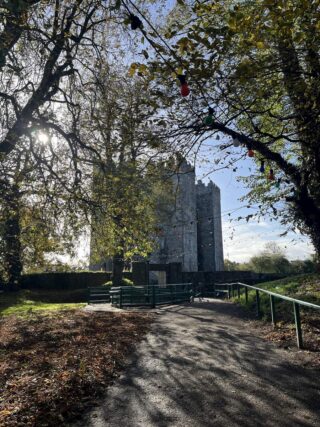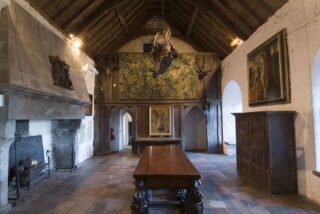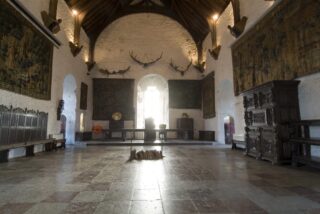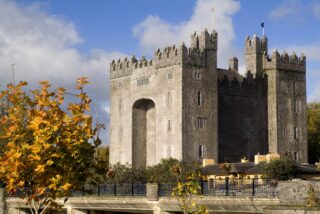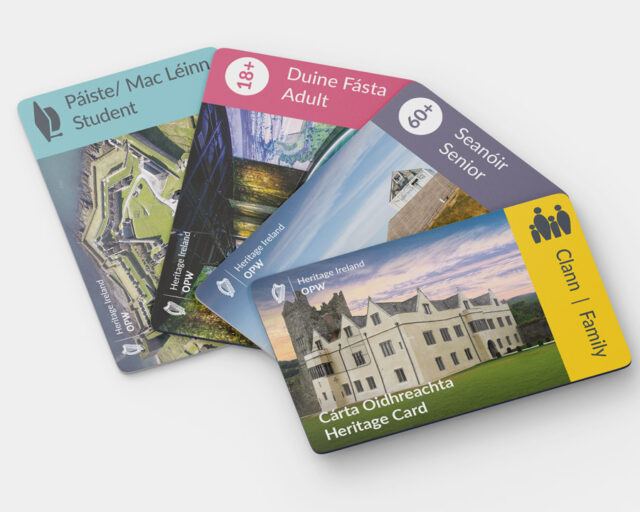Notice
Bunratty Castle is a National Monument in state guardianship
WARNING: It should be noted that these sites are unguided and a level of care and caution should be maintained during all stages of your visit. The Office Of Public Works (OPW) will not be held responsible for any damages, injuries, or losses that occur
Bunratty Castle
Bunratty Castle, on the banks of the Qwenogarney River, was originally one of four castles recorded at Bunratty in the 13th century. One of the other castles was built for Robert de Muscegros in 1251, and was an earth and wood structure with a palisade of oaks, much akin to a ringfort. Another castle, built for Thomas de Clare in 1290 and refortified in 1353 for Thomas de Rokeby, is now part of the fabric of the present Bunratty Castle.
The Bunratty Castle you see today was built for Maccon MacNamara in the 15th century, with remains of an early structure mentioned above. Maccon MacNamara was noted for his piety and received a papal letter of thanks from Pope Eugenius IV. In the very early 16th century much of the MacNamara’s estates, including Bunratty Castle, had passed, peacefully, to the O’Brien’s of Thomond. The ‘Great Earl’, Donough O’Brien, made Bunratty Castle his headquarters from 1583 onwards. It was during the Tudor period when the O’Brien’s were ennobled to the title of Earl of Thomond on the policy of surrender and re-grant. The ‘Great Earl’ made many modifications to Bunratty Castle, including vaulting the corner towers and using elaborate plasterwork to decorate the walls and ceilings. During the Cromwellian period, Barnaby O’Brien, 6th Earl of Thomond, surrendered to parliamentary forces in March 1646. The O’Brien’s eventually returned to the area, building a new castle nearby at Dromoland. However, the parliamentary forces were defeated by the confederate army. Bunratty Castle was then granted to numerous Plantation families with the Studdert family in possession in 1725. During the Studdert’s custody of Bunratty Castle, much remodelling took place. A multi-storey house was built onto the external north face of the castle and a police station built into the west external face of the castle, later becoming an RIC barracks subsequently burned during the War of Independence. In the mid-19th century the Studdert’s, in an attempt to conserve the castle, put in concrete floor and tarred the felt roofs. In 1915 Thomas Studdert gave Bunratty Castle to the Board of Works.
In 1953/4 Standish Vereker, 7th Viscount Gort, purchased the castle on the advice of John Hunt (his collection forms the basis of The Hunt Museum) and architect Percy Le Clerc. The Board of Works, Irish Tourist Board and Shannon Development were also involved. Viscount Gort restored the castle with most of the later building additions removed, including the Studdert home and barracks. Fireplaces, wood panelling and furniture were inserted, along with 100 panels of stained and heraldic glass inserted into the windows. Vereker is commemorated in the castle with portraits of him and his wife Bessy, and with a plaque near the portcullis. Bunratty Castle opened to the public in the 1960’s.
Protect our Past - Click here to read about the importance of protecting our country’s unique heritage sites
This national monument is protected in accordance with the National Monuments Acts 1930 to 2014
Gallery
Nearby sites to visit
Lough Gur Visitor Centre and Lakeshore Park
9,000 years of life
Approx. 27.9 km from Bunratty Castle
Desmond Castle Newcastlewest
Where sounds of medieval revelry echo around the walls
Approx. 32.4 km from Bunratty Castle
Scattery Island Monastic Site and Visitor Centre
Discover the History, Myth and Legend of Scattery Island
Approx. 48.7 km from Bunratty Castle

